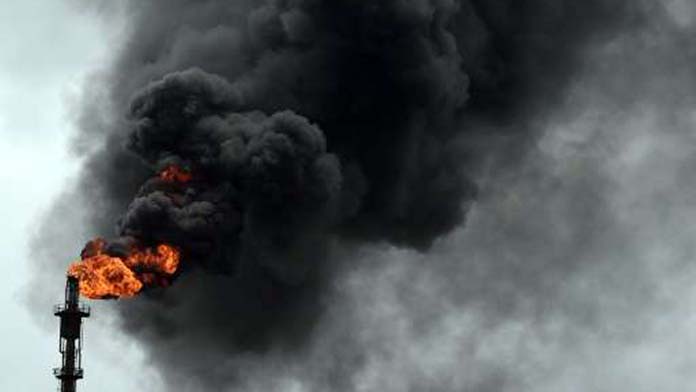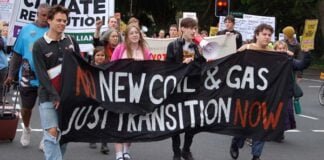James Supple examines why carbon offsets are a climate disaster that don’t genuinely reduce emissions—and why Labor is so committed to them
The offsets scam is one of the starkest failures of the Albanese government’s climate policies. Although Labor went to the election claiming it would finally deliver climate action, its priority is backing the coal and gas companies.
Offsets have become big business. The market in domestic carbon offsets in Australia was already worth an estimated $226 million in 2021.
Some environmental organisations are even involved in the trade, lending it legitimacy as a way to fund environmental projects. But the industry in Australia is also “increasingly influenced by fossil-fuel interests”, according to Nick Feik in The Monthly.
He found that “all of the largest carbon aggregators dealing in the carbon-credits market are now either part-owned by companies with major gas interests or count ex-resources executives as directors and/or major shareholders”.
Gas company Santos even runs its own offset projects in avoided deforestation in PNG as well as carbon capture and storage. These will not just offset its own polluting operations but “create new revenue streams” through selling offsets to other polluters, CEO Kevin Gallagher says.
It’s no surprise that the fingerprints of the fossil fuel companies are all over the offset trade—since the surge in emissions from new coal and gas projects will require masses of them.
Offsets are presented as a way to capture and store carbon to cancel out emissions from polluting industries. But this is a fraud. Offsets are never equivalent to the carbon from burning fossil fuels they supposedly replace.
One reason why is explained in a recent report by the research institute Climate Analytics.
Carbon released into the atmosphere stays there for a long time. After 100 years around 40 per cent of any carbon dioxide released remains in the air, and up to 25 per cent is still there after 1000 years. Even 10,000 years later 20 per cent can remain in the atmosphere.
There is no way that any offset project is going to keep carbon buried for this long. Trees or vegetation can die in droughts or burn down in bushfires, as trees used to offset at least six million tonnes of carbon have in a series of fires in California since 2015.
Add in the fact that bushfires are going to become more fierce and more frequent as the planet warms and there’s an obvious problem.
Yet under Australia’s official carbon credit scheme, offsets are regarded as permanent if they last for just 100 years.
-Worse, offset schemes that last just 25 years are also accepted and simply given a “discount rate” of 20 per cent. That means they are counted as permanently cancelling out 80 per cent of the total carbon they hold—even though there is nothing permanent about them.
Measuring offsets
Then there are “integrity issues” with the way offset projects are assessed. Companies profiting from offsets have an interest in cooking the books to claim as many offset credits as possible from their projects. Every extra credit for carbon they claim to store means more profit.
The result is projects inflate the amount of carbon or don’t offset any carbon at all, so that offsetting has been plagued by scandal.
Earlier this year Four Corners exposed how commercial logging was destroying forest supposedly being protected as a carbon offset by a US company in Papua New Guinea. It had sold 1.3 million carbon credits to clients including law firms, the Sydney Opera House and Planet Ark.
In January an investigation into world leading carbon offset certifier Verra found more than 90 per cent of its rainforest offset credits were fraudulent. The company has issued more than one billion carbon credits to companies including Disney, Shell and Gucci.
The Australian government runs its own offset scheme, meant to be a “world’s best practice”, certified by the Clean Energy Regulator.
Under the Safeguard Mechanism, companies can only use its Australian Carbon Credit Units (ACCUs) as offsets (or buy Safeguard Mechanism Credits from companies that make real emissions reductions beyond their targets under the scheme).
“Everyone thinks carbon credits are about trees being planted but this activity in fact represents just 2.5 per cent of all credits issued by the government,” Nick Feik pointed out in The Monthly.
Last year academic Andrew Macintosh produced a series of explosive studies that show the methods used to assess carbon offset projects in Australia are a farce.
“People are getting ACCUs for not clearing forests that were never going to be cleared; they are getting credits for growing trees that are already there; they are getting credits for growing forests in places that will never sustain permanent forests; and they are getting credits for operating electricity generators at large landfills that would have operated anyway,” he said.
Three methods made up 75 per cent of all offsets at the end of 2022. Macintosh found that more than 70 per cent of them “do not represent genuine emissions abatement”.
The largest is “human induced regeneration” of land, where forest and vegetation are allowed to regrow on land that was previously cleared. This has overwhelmingly occurred in arid or semi-arid areas where re-vegetation is the result of rainfall, Macintosh says, meaning the regrowth may not survive permanently through drier years.
The second largest, burning gas produced by landfill, already makes money for rubbish disposal companies. Most of it would have happened anyway—meaning there are often no additional emissions avoided by allowing it to generate offset credits.
Avoided deforestation, where a farmer or company promises not to clear land, comes third.
Macintosh’s criticisms, especially of land regeneration, have also received the backing of the CSIRO and the Wentworth Group of Scientists.
A review for the Albanese government led by Ian Chubb, however, dismissed them, declaring the scheme “essentially sound”. It even disregarded work specifically commissioned for the review from the Australian Academy of Sciences, which echoed the criticisms.
The only offsets it ruled out were for avoided deforestation, which applied to areas in NSW where there were unused land clearing permits more than ten years old, raising major question marks over whether the land was ever going to be cleared.
New guidelines were also recommended for land regeneration offsets. But as Macintosh points out, applying them “depends on the Clean Energy Regulator” which “has refused to admit there are any problems”.
The review also endorsed allowing all the dodgy credits already generated to stay in the market.
Companies have already begun hoarding them for use under the Safeguard Mechanism. Oil and gas company Woodside says it has already bought almost all the credits it needs until 2030.
Biodiversity offsets
Allowing harmful emissions and then trying to offset them, instead of simply stopping them in the first place, is a disaster. But the Labor government thinks offsetting is such a great idea it is moving to open a similar market in biodiversity.
The want companies to buy biodiversity credits as an act of philanthropy—or to greenwash their image. Companies might also be allowed to destroy one fragile ecosystem in exchange for protecting another area.
It’s needed, they say, because the government can’t afford the $1 billion-$2 billion a year to stop biodiversity loss.
Peter Dutton and the Liberals have given their support since it mirrors a Coalition proposal.
It’s not clear many companies will want to participate—but it would be another step to entrenching the idea that offsets can help the environment.
Labor’s climate disaster
Acting on climate change is straightforward. We need to stop burning fossil fuels and shift to new forms of energy.
But the Albanese government is determined to allow coal and gas companies to keep digging up fossil fuels for as long as possible. The industry makes gigantic profits, raking in between $120 and $140 billion last year. That’s why Labor is dancing to their tune.
Resources Minister Madeleine King has insisted Australia will still be selling coal and gas after 2050, declaring, “I think we go beyond the middle of the century, I really do.” This threatens even plans for net zero emissions by 2050, a target Scott Morrison signed up to.
Offsets are central to the Safeguard Mechanism, Labor’s central policy for tackling emissions.
Labor’s initial plans would have allowed companies to rely entirely on offsets to meet their reduction targets. This would have seen no restrictions on new coal and gas mines as long as they bought offsets.
The changes The Greens negotiated put some limits on this. There are now two targets under the scheme. Actual emissions, excluding any offsets, will be capped at existing levels. The scheme is, however, supposed to reduce emissions across industry by 28 per cent by 2030.
Companies, including coal and gas projects, can still rely entirely on offsets to meet these targets.
This means there’s a huge question over whether it will reduce emissions at all.
And it gets worse. Any genuine cuts to emissions that companies make, say by installing new technology to use renewable sources of energy, will allow more coal or gas projects, since they provide more room under the cap on actual emissions.
This shows the farce of Labor’s overall 43 per cent emissions reduction plan by 2030. Not only is it far short of the 75 per cent cut needed to avoid dangerous warming above 1.5 degrees. It relies on the same kind of dodgy carbon accounting tricks as the Coalition did.
Total emissions across the Australian economy have actually only decreased by 1.1 per cent since 2005. The rest of the 22 per cent decrease comes from land use changes including reduced land clearing, based on the same phony idea as offsetting that increased vegetation, which can burn down or die, can cancel out industrial emissions.
This means we still have a big fight ahead to stop Labor’s dance with climate disaster.






